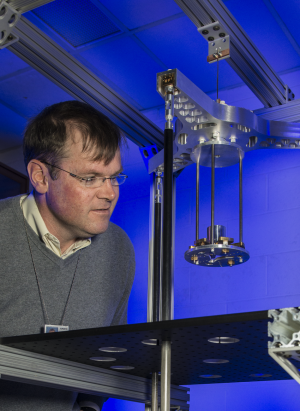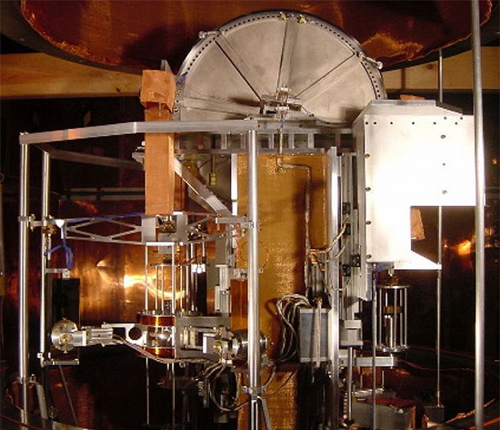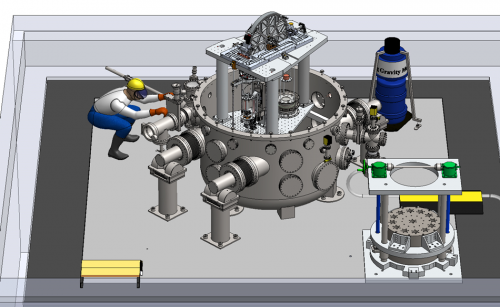New value for the Planck constant may hasten electronic kilogram

(Phys.org) —After two years of difficult and meticulous work examining, refurbishing, and testing the aging workhorse watt balance called NIST-3, PML researchers have used the instrument to obtain their latest measured value of the Planck constant – the first to be released since 2007, and presumably the last to be measured on NIST-3 before its successor, NIST-4, begins operation later this year.
The new result, 6.626 069 79 x 10-34 J•s (with an uncertainty of 30 in the last two digits), differs from the 2007 value. But it brings NIST closer to the most recently published high-precision figures from the National Research Council of Canada, and the value announced by the International Avogadro Consortium in 2010. The growing agreement among these three may hasten progress toward the long-awaited redefinition of the kilogram.
The International Committee on Weights and Measures (CIPM) is considering a plan to redefine all seven SI base units in terms of constants of nature. In particular, the kilogram – the last of the base units to be defined by an artifact – will be tied to a fixed value of the Planck constant, h. At present, watt-balance measurements of h are made by using a precisely known mass such as NIST's prototype kilogram No. 85. In the redefinition, conversely, the kilogram mass will be realized by using a fixed value of the Planck constant.
The pursuit of an authoritative value has prompted intense activity around the world. "The redefinition plan could be approved this year at a meeting of the General Committee on Weights and Measures (CGPM)," says Jon Pratt, who heads the Fundamental Electrical Measurements group in PML's Quantum Measurement Division. "So the international timeline for the Planck constant is very aggressive. New or upgraded watt balances are coming on line at metrology institutes in Switzerland, Korea, France, New Zealand, and elsewhere, as well as at the International Bureau of Weights and Measures. It's quite possible that we will be realizing mass with these instruments some time in 2015."
But that depends on whether a consensus value of h emerges that meets the criteria specified by a CIPM consultative committee: At least three independent experiments must produce values with a relative standard uncertainty of no more than 50 parts in 109; one of them must have an uncertainty of 20 parts in 109 or better; and watt-balance results must be reconciled with an alternative (Avogadro) method, which involves counting atoms in an ultra-pure sphere of silicon.
Until very recently, that seemed a distant goal. Then in 2012, NRC published its watt-balance value for h, as well as a value calculated from an Avogadro sphere that NRC had been asked to assess. The two values differed by only 12 parts in 109, and both experiments reported uncertainties below 50 parts in 109. Those values, however, were substantially different from NIST's 2007 value.

As it happened, NIST had already called for a complete, independent examination of NIST-3 in 2010 after the instrument began to produce values inconsistent with years of prior measurement.
"We just sort of hit 'reset'," says Stephan Schlamminger, who heads PML's electronic kilogram project. "We brought in a completely new crew, investigated every connection, re-evaluated our corrections for gravity, re-measured all critical parameters, made improvements in electrical, mechanical, and quantum-mechanical systems, re-aligned key components, and more."
Modifications ranged from replacing the knife-edge on the balance beam to upgrading the programmable Josephson voltage standard system. NIST also sent K85, one of its platinum-iridium kilogram prototypes, to BIPM for recalibration. By late 2012, they were ready to take data. Measurements were finished by the end of October of last year.
Ordinarily, that would be the whole story, and the researchers would proceed to calculate their value and assign an uncertainty budget to the result. But Schlamminger had added one more unusual feature on his way to a final value: The experiment was initially conducted blind. That is, the mass used to determine h was the prototype kilogram plus a certain additional "offset," the exact magnitude of which was unknown to experimenters.
In a dramatic flourish that happened at the mid-point of the measurement campaign, a preliminary value was revealed at the watt balance technical meeting held in Ottawa in June of 2013. Before a rapt audience of technical peers, Schlamminger fielded a call on speaker phone from the NIST mass and force group informing him for the first time of the actual value of the offset. Using a spreadsheet embedded in his presentation, Schlamminger immediately projected the new NIST value alongside the NRC and Avogadro results. After a brief, stunned silence, the crowd of experts burst into applause, immediately recognizing the shift and its ramifications.

The PML team cannot be sure that any or all of the NIST-3 upgrades are responsible for the new Planck constant value, but "the weight of evidence from our peers seems to suggest that whatever we changed, at least from their perspective, was in the right direction," Pratt says with a wry smile. The latest NIST value is still considerably lower than the NRC's published value.
Soon the researchers may have to deal with yet other, potentially discrepant, values from the host of other proposed balances, including their own, NIST-4, now being assembled in NIST's advanced measurement laboratories. NIST-3 is unique in the world in that it has a superconducting electromagnet to provide the field, instead of a permanent magnet. That feature, conceived to produce a stable, yet variable field, has proven unwieldy, since it requires the liquid helium coolant to be refilled three times a week, thus making operating the instrument costly and labor intensive.
NIST-4 will have a permanent magnet and will be much easier to operate. NIST-3 will be mothballed, but kept workable. "It provides a great developmental test stand," Schlamminger says, "and we'll probably find a lot of uses for it."
Pratt is optimistic but cautious about the future. "The international community would like to be doing trial runs of a mise en practique to realize the kilogram in 2015," he says, "and we have to be ready for that. NIST-4 may come up with somewhat different values from what we got on NIST-3, which itself has varied over time. Whatever happens, we're going to be working very hard. But then, we signed up for that."
Provided by National Institute of Standards and Technology


















